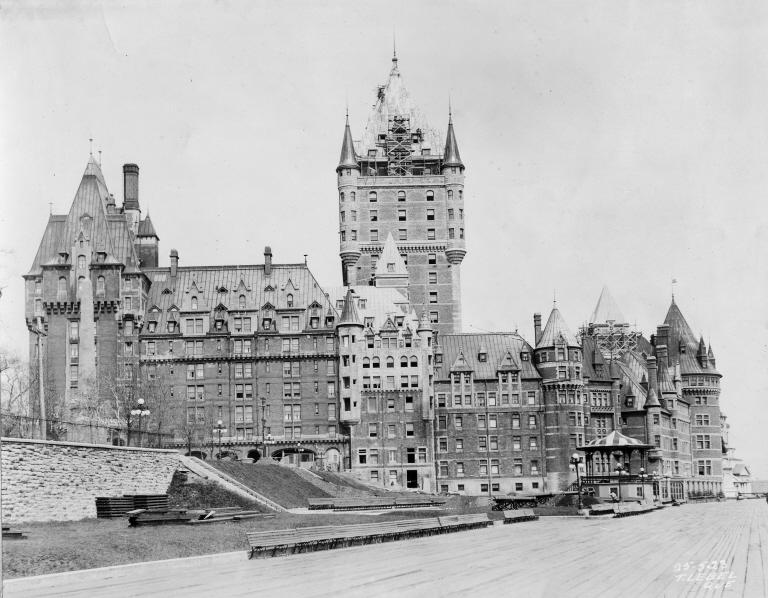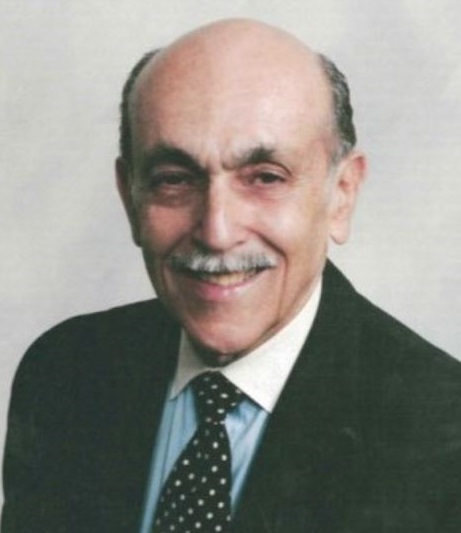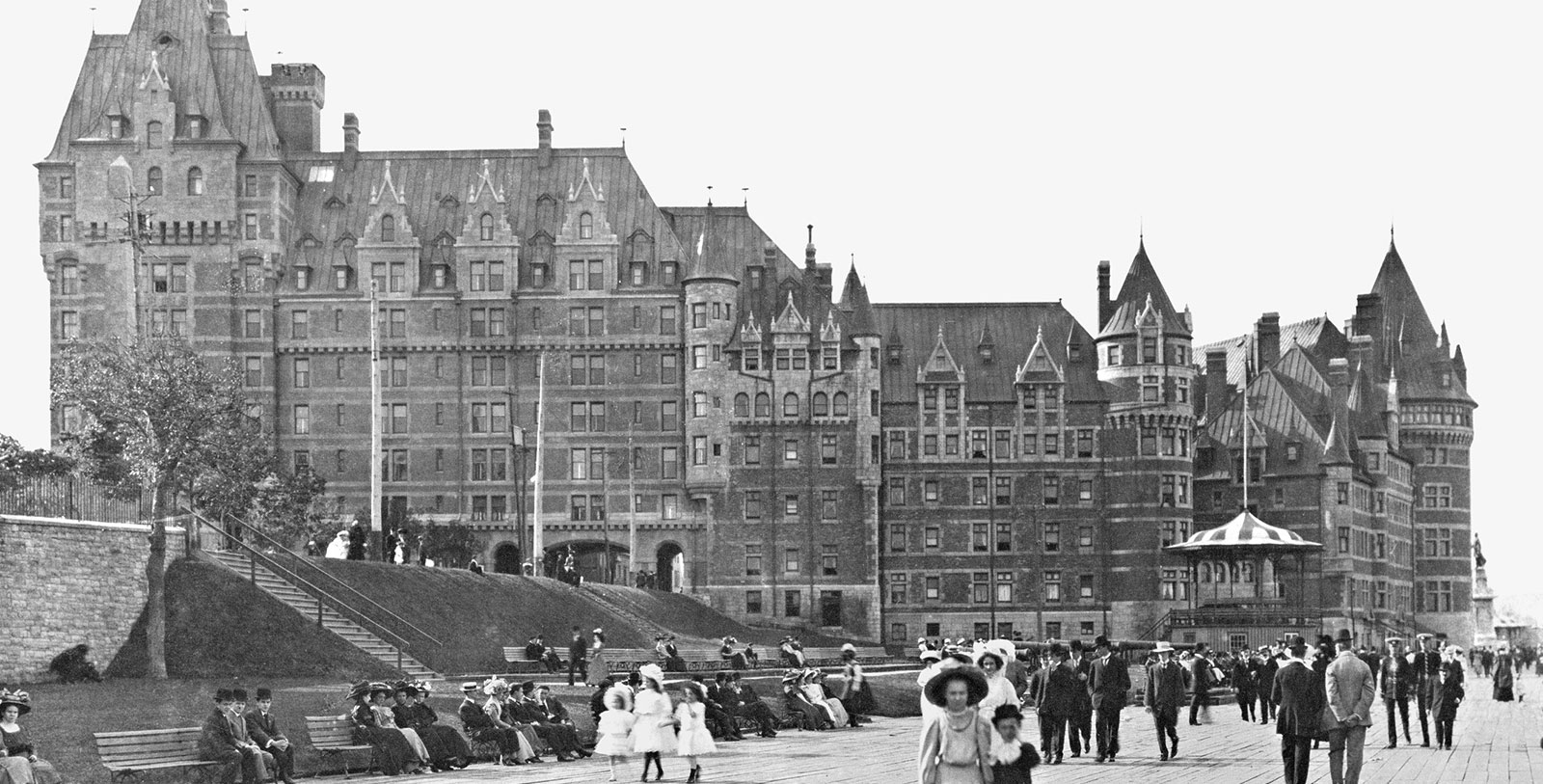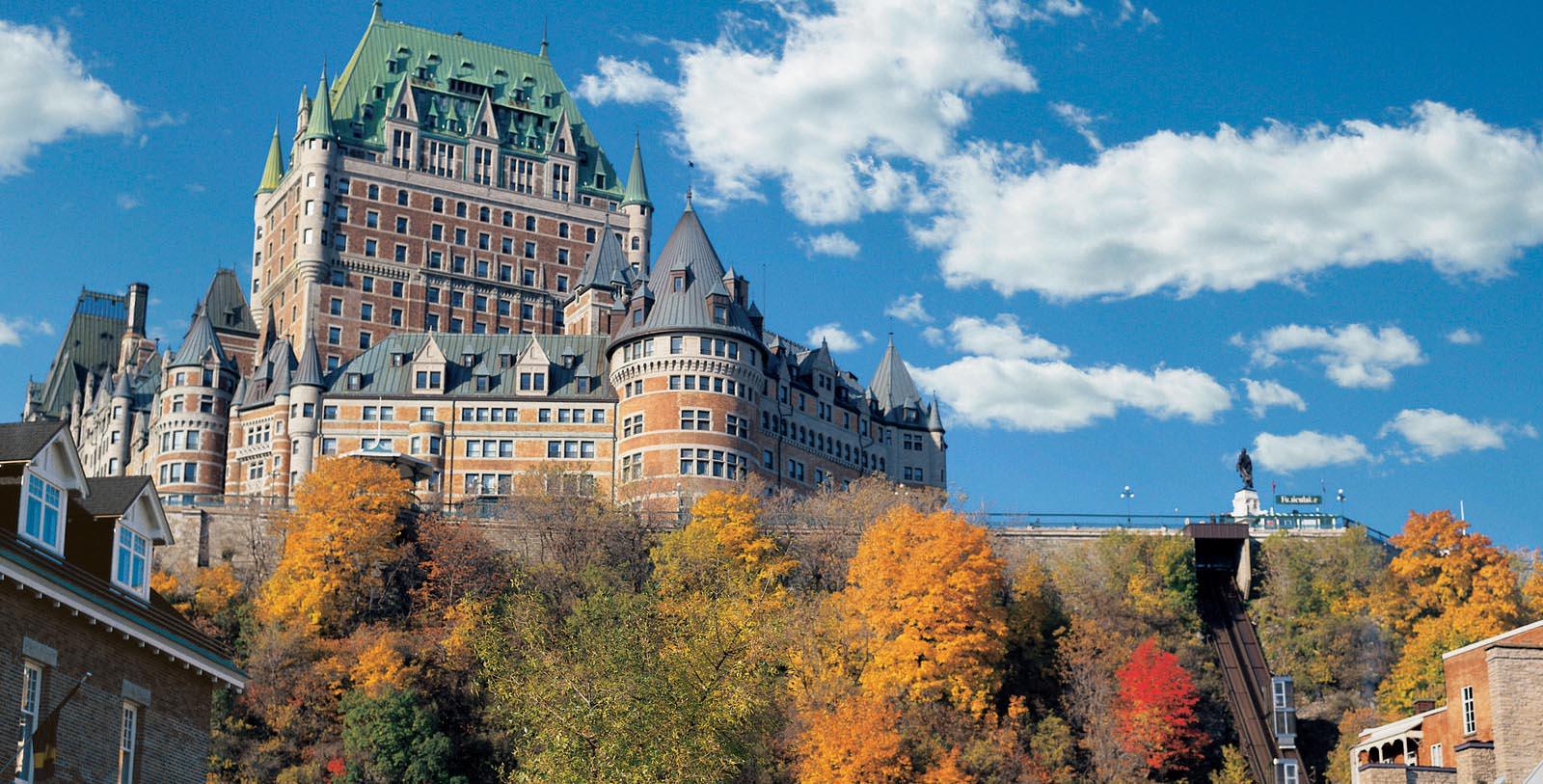Receive for Free - Discover & Explore eNewsletter monthly with advance notice of special offers, packages, and insider savings from 10% - 30% off Best Available Rates at selected hotels.
history
Discover the Fairmont Le Château Frontenac, which has been among Canada’s most prominent holiday destinations for more than a century.
Fairmont Le Château Frontenac, a member of Historic Hotels Worldwide since 2012, dates back to 1892.
VIEW TIMELINE
The Grand Makeover of the Fairmont Le Château Frontenac
Discover more than a hundred years of history at the revitalized Fairmont La Château Frontenac! Just moments away from La Citadelle de Québec, this fantastic historic hotel is one of Québec City's most celebrated landmarks.
WATCH NOWListed as a National Historic Site of Canada, the Fairmont Le Château Frontenac is among the nation’s most celebrated historic landmarks. This spectacular retreat is located in the heart of Old Québec, which served as the seat of colonial French power in North America over the better part of two centuries. It was from this location that France presided over thousands of acres that stretched from the Great Lakes to the bayous of Louisiana. Old Québec then became the headquarters in Canada for the British when they wrestled control of the region away from France during the Seven Years’ War. Fairmont Le Château Frontenac resides on the grounds of the former Château St. Louis, which functioned as the main administrative office for both the French and British colonial governments in Québec City until it burnt down in 1834.
William Van Horne, President of the Canadian Pacific Railway, chose the site of the former Château St. Louis as the location for an extravagant hotel. The ambitious railroad magnate had hoped to spur travel along his company’s new rail lines by developing a series of ornate lodgings that could appeal to upscale travelers. As such, he decided to construct what would become the Fairmont Le Château Frontenac in downtown Québec City for just that purpose. Van Horne hired the renowned American architect Bruce Price to create the building’s design and construction began shortly thereafter in 1892. Price had used a special architectural style known as “Châteauesque,” which borrowed heavily from Revivalist and French Renaissance design aesthetics. As such, the new hotel resembled a grand historic manor native to France’s Loire Valley. When it finally debuted a year later, Van Horne chose to name the building as the “Château Frontenac Hotel” in honor of the region’s legendary colonial governor, Louis de Buade de Frontenanc.
Fairmont Le Château Frontenac has since emerged as one of the world’s preeminent holiday destinations. Countless international luminaries have stayed at this spectacular hotel over the years, including military aviator Charles Lindberg, Princess Grace Kelly of Monaco, and French President Charles de Gaulle. Even Queen Elizabeth II of the United Kingdom visited the Fairmont Le Château Frontenac in the past. The hotel’s magnificent architecture and beautiful décor also inspired the famous film director, Alfred Hitchcock, to shoot portions of his classic thriller, I Confess, onsite in 1953. But Fairmont Le Château Frontenac has been the site of major historical events as well, such as the Quebec Conferences of World War II. Held between 1943 and 1944, these meetings were chaired by U.S. President Franklin Delano Roosevelt, British Prime Minister Winston Churchill, and Canadian Prime Minister William Lyon Mackenzie King. Together, they discussed invasion plans for Western Europe, as well as the shape of the postwar world. Fairmont Le Château Frontenac is a member of Historic Hotels Worldwide.
-
About the Location +
The Fairmont Le Château Frontenac is located along the eastern section of Québec City’s historic Upper Town. Upper Town is one of the neighborhoods that constitute Old Québec, which UNESCO designated a World Heritage Site in 1985. Old Québec is among the most historic communities in North America, as its roots trace all the way back to the founding of Fort Saint Louis some 400 years ago. In fact, French explorer Samuel de Champlain led the first French colonists to the area in 1608—roughly one year after the English established Jamestown in the Colony of Virginia. Fort Saint Louis would eventually grow into the epicenter of the Colony of New France before the British acquired it—as well as the rest of Canada—after France’s defeat in the Seven Years’ War. Fairmont Le Château Frontenac has paid homage to this lineage throughout its entire existence as its name is a derivative of Louis de Buade de Frontenanc, who served as Governor General of New France for many years. Buade de Frontenac is historically remembered throughout Québec City as a successful guerrilla fighter who miraculously saved the colony against a massive British invasion during King William’s War.
Today, most of the historic structures in the Upper Town originate from the late 19th century when developers in Québec City demolished most of the earlier buildings. Yet, a number of those landmarks from the city’s formative years still survive, nevertheless. Fairmont Le Château Frontenac is close to a few of these sites, including the Old Port, La Citadelle de Québec, Château St. Louis, the Plains of Abraham, and the Place Royale. Two of Old Québec’s most celebrated landmarks—La Citadelle de Québec and the Plans of Abraham—are only a few blocks from the hotel’s front door. La Citadelle de Québec is actually a British structure built in 1820, which represented the British Crown’s efforts to protect Canada following the War of 1812. It is still an active military base and functions as Queen Elizabeth II’s “official” residence in the country. The Plans of Abraham is just to the south of La Citadelle de Québec and marks the site of a great battle during the French and Indian War. Known officially as the Battle of the Plains of Abraham, the contest saw the British seize control of Québec City from the French in 1759.
-
About the Architecture +
The Fairmont Le Château Frontenac is one of Canada’s iconic Châteauesque Grand Dame hotels. Like many of its fellow Châteauesque-style hotels, the Fairmont Château Le Frontenac resembles the type of grand French manor that emerged in the Loire Valley throughout the late 15th to the early 17th centuries. This unique architectural style blends elements of Revivalist and French Renaissance design aesthetics to achieve its distinctive appearance. Buildings constructed in such a way are also known to incorporate pitched roofs and elaborate towers that borrow heavily from Gothic and Italian Renaissance architecture. (In the case of the Fairmont Le Château Frontenac, the architectural team avoided using Italian Renaissance-style architecture entirely in favor of Gothic.) Many historians today consider the Fairmont Le Château Frontenac to be among the best examples of Châteauesque-style architecture in the entire world.
When William Van Horne, President of the Canadian Pacific Railway Company, initiated the construction of the Fairmont Le Château Frontenac, he hired the renowned American architect Bruce Price to create its design. An innovator of the “Shingle Style,” Price’s work later influenced many famous architects, including Frank Lloyd Wright. Starting in 1892, Price would oversee the development of the hotel’s famous look over the next three years. His plan called for a layout reminiscent to that of a horseshoe, made of four irregular wings that he would connect at obtuse angles. Most of its public spaces would occupy the first two floors, while the remaining dozen or so would feature hundreds of accommodations. He used grey stone ashlar and Glenboig brick cladding as the primary building material for the façade. Inside, Price and his team employed mahogany paneling, wrought iron, and carved stone to masterful effect. One of the most striking features of Price’s design involved the hotel’s front entrance. He constructed this portion of the building by crafting several porte-cochère that contained large dormers and a cupola. The porte-cochère led guests directly into the grand courtyard, as well as access to the main lobby. Guests today will notice a 300-year-old stone bearing the Cross of Malta as they walk through into the lobby from the porte-cochère.
The hotel underwent a handful of expansions since its debut in 1893, the first of which transpired six years later with the addition of the Citadel Wing. Architect William Sutherland Maxwell would preside over the next two construction projects, culminating with his work the hotel during the 1920s. Working alongside his brother, Edward, Maxwell created a marvelous central tower that caused the hotel to stand some 260 feet in length. As such, the Fairmont Le Château Frontenac was the tallest building in Québec City until 1930. Another fabulous addition made during the Maxwell’s last renovation was the creation of the Verchères Space’s historic ceiling. The original sketch for the structure was drawn by William Maxwell himself. Hand-painted, the ceiling included designs of leaves and flowering vines embellished with cartouches and monochrome motifs. Its palette featured hues of blue and green cast against an exquisite background of yellow. Palm stenciling was also used on every column installed within the room, as the first name for the Verchères Space was the “Palm Court.” These images are still visible in the Verchères Space to this very day.
More recently, the Fairmont Le Château Frontenac received two extensive renovations in 1993 and 2011. The first of these renovations involved the architectural firm Arcop, a Montréal-based company that had previously designed such buildings like the Place Ville Marie and the Place des Arts. Despite having worked with more modern structures, Arcop wonderfully modernized the Fairmont Le Château Frontenac while also preserving its rich, architectural character. The highlight of the restoration was the then-cutting-edge Claude-Pratte Wing. The structure featured such wonderful facilities, like an indoor swimming pool, fitness center, and a magnificent exterior terrace. The renovations that occurred in 2011 were just as comprehensive, as they focused on refurbishing the hotel’s restaurants, its grand lobby, and nearly three-fifths of its available accommodations. But the greatest area of work concerned the iconic Châteauesque-style roof. A fair amount of the $66 million renovation budget went toward replacing the building’s prominent copper pitched roofs, so that many more guests could appreciate them for generations to come.
-
Famous Historic Events +
First and Second Quebec Conferences (1943 and 1944, respectively): Referred collectively among historians as the Quebec Conferences, these two important historical events were a series of highly confidential meetings in which the Western Allies planned the invasion and subsequent occupation of Western Europe during World War II. In each of these meetings, U.S. President Franklin Delano Roosevelt, British Prime Minister Winston Churchill, and Canadian Prime Minister William Lyon Mackenzie King specifically led the conversation. During the first conference in August of 1943, the three politicians planned the invasion of Normandy, scheduled tentatively for the following spring. The men represented the three Western nations that would make the greatest contribution to the upcoming assault. Then in September of 1944, the statesmen met at the Second Quebec Conference to mainly discuss the shape of postwar Europe. They also addressed plans to defeat the Japanese Empire, including the proposed use of atomic weaponry.
-
Famous Historic Guests +
Charles Lindbergh, historic aviator and military officer.
Alfred Hitchcock, influential filmmaker of such classics like Vertigo, North by Northwest and Psycho.
Princess Grace Kelly of Monaco, famous American film actress known for Mogambo and wife of Prince Rainier III.
Québec Premier Maurice Duplessis (1936 – 1939; 1944 – 1959)
Charles de Gaulle, World War II freedom fighter and President of France (1959 – 1969)
Prime Minister William Lyon Mackenzie King of Canada (1921 – 1926; 1926 – 1930; 1935 – 1948)
Queen Elizabeth II of the United Kingdom (1952 – 2022)
Prime Minister Winston Churchill of the United Kingdom (1940 – 1945; 1951 – 1955)
Franklin Delano Roosevelt, 32nd President of the United States (1933 – 1945)
-
Film, TV and Media Connections +
I Confess (1953)
Blizzard (2003)
Taking Lives (2004)
Guardian: The Lonely and Great God (2016)

Guest Historian Series
Nobody Asked Me, But… No.240;
Hotel History: Le Chateau Frontenac, Quebec City, Canada (1893)
By Stanley Turkel, CMHS
Listed as a National Historic Site of Canada, the Fairmont Le Château Frontenac is among the nation’s most celebrated historic landmarks. This spectacular retreat is located in the heart of Old Québec, which served as the seat of colonial French power in North America over the better part of two centuries. It was from this location that France presided over thousands of acres that stretched from the Great Lakes to the bayous of Louisiana. Old Québec then became the headquarters in Canada for the British when they wrestled control of the region away from France during the Seven Years’ War. Fairmont Le Château Frontenac resides on the grounds of the former Château St. Louis, which functioned as the main administrative office for both the French and British colonial governments in Québec City until it burnt down in 1834.
American William Van Horne, President of the Canadian Pacific Railway, chose the site of the former Château St. Louis as the location for an extravagant hotel. The ambitious railroad magnate had hoped to spur travel along his company’s new rail lines by developing a series of ornate lodgings that could appeal to upscale travelers. As such, he decided to construct what would become the Fairmont Le Château in downtown Québec City for just that purpose. Van Horne hired the renowned American architect Bruce Price to create the building’s design and construction began shortly thereafter in 1892. Price had used a special architectural style known as “Châteauesque,” which borrowed heavily from Revivalist and French Renaissance design aesthetics. As such, the new hotel resembled a grand historic manor native to France’s Loire Valley. When it finally debuted a year later, Van Horne chose to name the building as the Château Frontenac Hotel” in honor of the region’s legendary colonial governor, Louis de Buade de Frontenac.
Fairmont Le Château Frontenac has since emerged as one of the world’s preeminent hotel destinations Countless international luminaries have stayed at this spectacular hotel over the years, including military aviator Charles Lindbergh, Princess Grace Kelly of Monaco, French President Charles de Gaulle and Queen Elizabeth II of the United Kingdom visited the Fairmont Le Château Frontenac in the past. The hotel’s magnificent architecture and beautiful décor also inspired the famous film director, Alfred Hitchcock, to shoot portions of his classic thriller, I Confess, onsite in 1953 starring Montgomery Clift and Anne Baxter. But Fairmont Le Château Frontenac has been the site of major historical events as well, such as the Québec Conferences of World War II. Held between 1943 and 1944, these meetings were chaired by U.S. President Franklin Delano Roosevelt, British Prime Minister Winston Churchill, and Canadian Prime Minister William Lyon Mackenzie King. Together, they discussed invasion plans for Western Europe, as well as the shape of the postwar world.
In 1993, the hotel saw another expansion, with the addition of the new wing that included a pool, fitness centre, and outdoor terrace. On June 14, 1993, Canada Post issued ‘Le Château Frontenac, Québec’ designed by Kosta Tsetsekas, based on illustrations by Heather Price. The stamp features an image of the hotel building, and is printed by Ashton-Potter Limited.
In 2001, the hotel was sold to Legacy REIT, which is partially owned by Fairmont, for $185 million. The hotel was renamed the Fairmont Le Château Frontenac in November 2001, shortly after Canadian Pacific Hotels reformed itself as Fairmont Hotels and Resorts, taking the name of an American company it acquired in 2001.
In 2011, the hotel was sold to Ivanhoé Cambridge. Shortly after acquiring the hotel, Ivanhoé Cambridge announced an investment of $9 million for the restoration of the building’s masonry work, and to replacement of the building’s copper roofs. The company further announced another $66 million investment for general improvements and renovations throughout the hotel. When the roof was being replaced, an image of the roof was printed on polypropylene safety netting and hung from scaffolding to hide the refurbishing project from view. The extensive renovation saw conference rooms expanded, restaurants remodeled, modernization of the lobby, and the gutting and rebuilding of three-fifths of hotel’s rooms.
*****
About Stanley Turkel, CMHS
Stanley Turkel is a recognized consultant in the hotel industry. He operates his hotel consulting practice serving as an expert witness in hotel-related cases and providing asset management an and hotel franchising consultation. Prior to forming his hotel consulting firm, Turkel was the Product Line Manager for worldwide Hotel/Motel Operations at the International Telephone & Telegraph Co. overseeing the Sheraton Corporation of America. Before joining IT&T, he was the Resident Manager of the Americana Hotel (1842 Rooms), General Manager of the Drake Hotel (680 Rooms) and General Manager of the Summit Hotel (762 Rooms), all in New York City. He serves as a Friend of the Tisch Center and lectures at the NYU Tisch Center for Hospitality and Tourism. He is certified as a Master Hotel Supplier Emeritus by the Educational Institute of the American Hotel and Lodging Association. He served for eleven years as Chairman of the Board of the Trustees of the City Club of New York and is now the Honorary Chairman.
Stanley Turkel is one of the most widely-published authors in the hospitality field. More than 275 articles on various hotel subjects have been posted in hotel magazines and on the Hotel-Online, Blue MauMau, Hotel News Resource and eTurboNews websites. Two of his hotel books have been promoted, distributed and sold by the American Hotel & Lodging Educational Institute (Great American Hoteliers: Pioneers of the Hotel Industry and Built To Last: 100+ Year-Old Hotels East of the Mississippi). A third hotel book (Built To Last: 100+ Year-Old Hotels in New York) was called "passionate and informative" by the New York Times. Executive Vice President of Historic Hotels of America, Lawrence Horwitz, has even praised one book, Great American Hoteliers Volume 2: Pioneers of the Hotel Industry:
- “If you have ever been in a hotel, as a guest, attended a conference, enjoyed a romantic dinner, celebrated a special occasion, or worked as a hotelier in the front or back of the house, Great American Hoteliers, Volume 2: Pioneers of the Hotel Industry is a must read book. This book is recommended for any business person, entrepreneur, student, or aspiring hotelier. This book is an excellent history book with insights into seventeen of the great innovators and visionaries of the hotel industry and their inspirational stories.”
Turkel was designated as the “2014 Historian of the Year by Historic Hotels of America,” the official program of the National Trust for Historic Preservation. This award is presented to an individual for making a unique contribution in the research and presentation of history and whose work has encouraged a wide discussion, greater understanding and enthusiasm for American History.
Works published by Stanley Turkel include:
- Heroes of the American Reconstruction (2005)
- Great American Hoteliers: Pioneers of the Hotel Industry (2009)
- Built to Last: 100+ Year-Old Hotels in New York (2011)
- Built to Last: 100+ Year-Old Hotels East of the Mississippi (2013)
- Hotel Mavens: Lucius M. Boomer, George C. Boldt and Oscar of the Waldorf (2014)
- Great American Hoteliers Volume 2: Pioneers of the Hotel Industry (2016)
- Built to Last: 100+ Year-Old Hotels West of the Mississippi (2017)
- Hotel Mavens Volume 2: Henry Morrison Flagler, Henry Bradley Plant, Carl Graham Fisher (2018)
- Great American Hotel Architects Volume 1 (2019)
- Hotel Mavens Volume 3: Bob and Larry Tisch, Curt Strand, Ralph Hitz, Cesar Ritz, Raymond Orteig (2020)
Most of these books can be ordered from AuthorHouse—(except Heroes of the American Reconstruction, which can be ordered from McFarland)—by visiting www.stanleyturkel.com, or by clicking on the book’s title.
Contact: Stanley Turkel
stanturkel@aol.com/917-628-8549


























